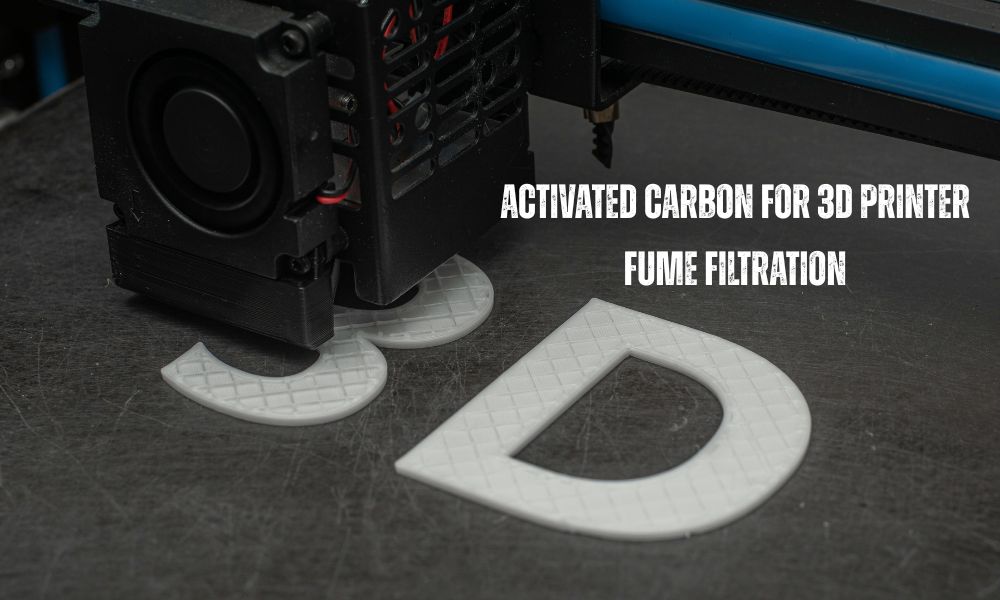
3D printers have revolutionized the education sector, professions, inventions, healthcare, and projects DIY. But as time is ticking, the technology is ticking so fast. The technology is widely used, and the quality of the air during printing has surfaced. Numerous 3D printing materials, including ABS, PLA, and resin, emit toxic fumes that contain ultrafine particles (UFPs), volatile organic compounds (VOCs), and other toxins that, if exposed for an extended period of time, may be harmful to one’s health.
This is where the application of activated carbon, which is a popular filtration method to reduce these hazards. Activated carbon is well known for its purification and filtration process. The adsorption capacity and porous structure improve the air quality around 3D printers by capturing odours and dangerous chemicals.
In this blog, we will cover the benefits of activated carbon for 3D printer fume filtration, how activated carbon works to filter harmful emissions, and the practical ways to integrate it the different applications.
What is 3D Printer fume filtration?
When your 3D print, the heating process releases different types of fumes:
Smelly chemicals: the gases that come from melting plastic like ABS, PLA, or nylon. They create a strong plastic smell notice.
Tiny dust particles: These are super small particles that float in the air and can get deep into your lungs when you breathe.
Harmful Gas: Some plastics release specific harmful gases – ABS releases something like car exhaust (styrene), while Nylon releases a chemical called caprolactam.
Why This Matters for Your Health?
- The fumes from the printer can create dizziness, headaches, or irritate your eyes, nose, throat.
- It leads to breathing problems or other hazardous health issues.
- Good ventilation or air filtration is so important, especially if you print in a small room.
What is activated carbon?
Activated carbon is a type of carbon characterized by a highly porous structure. These pores help increase the surface area to absorb contaminants. This is made from natural sources like coconut shells, coal, and wood. The porous structure gives activated carbon a high ability to absorb. it is necessary to ensure that the carbon undergoes certain activation, such as thermal or chemical induction. This activation procedure enables it to increase its porous structure, which helps in enabling maximum capacity.
How is this applied to 3D printer fume filtration?
- When the dirty air passes through activated carbon, the bad smells and chemicals stick to the carbon.
- It is great at removing those plastic fumes and odors from the emissions of 3D printing.
- The security of the printer catches the bad stuff while letting clear air through, that why many 3D printer owners add activated carbon to their setup.
How activated carbon filters 3D printer fumes.
Activated Carbon filters trap toxic gases and VOCs in porous structures through chemical bonding. Types include Granular Activated Carbon (GAC), Activated Carbon Foam, and Impregnated Carbon. They are effective against VOCs and odors but less effective for particulate matter, requiring a HEPA combo. They are lightweight and easy to integrate.
Types of Activated Carbon for Fume Filtration
1. Granular activated carbon: As this is in a solid shape structure apart from the powder, these granules help to trap the toxins. As air flows through, the fumes and smells stick to these little carbon pellets. Great for big filter systems, but air needs to move slowly for best results. Since it is in granular form, it can be used multiple times. The granular structure enables it to be used after being recycled and reused.
2. Pelletized activated carbon: Pelletized activated carbon is carbon compressed to form a particular shape, such as a spherical or cylindrical pellet. It is formed by compressing fine powder through a compressor and spreading it into uniform pellet shapes. This pellet carbon is carbonized and activated at high temperatures.
3. Activated carbon foam: Some carbon filters can be treated with a special chemical to target specific fumes. These kinds are useful when you print with smelly components.
4. Impregnated activated carbon: This type is mixed with special chemicals to use against certain special kinds of pollutants like heavy metals and harmful gases.
What makes Southern Carbon’s activated carbon a distinct product in air purification
Best adsorption Capacity: It is a high form of carbon manufactured specially with a network of pores initiating the best filtration and purification process.
To clean the volatile compounds:The product is designed to remove the VOC (volatile organic compounds) in the atmosphere. The fumes from the printer and the air are something that can’t be seen or touched; therefore, it need to be filtered using carbon. These pollutants contain volatile compounds, also have Benzene, xylene, and chlorinated compounds.
Versatile Application of Activated Carbon: Activated carbon is applicable for industrial and commercial purposes. The usage of carbon ensures optimum usage of air purification and attains optimal results.
Eco-friendly and sustainable nature: The usage of activated carbon ensures sustainability and eco-friendliness as it is a gradual and slow process. It incurs the minimum process cost, reduces operational cost, and reduces wastage.
Quality: The product ensures that cleaner processes start with superior filtration, activated carbon of the best quality helps to determine the air quality, allowing better air in the environment.
Adopting the treatments through activated treatment can help contribute to a healthier and safer community. Therefore, Southern Carbon is the perfect choice for Activated carbon manufacturers in India. We are established as a trusted and dependable partner in the activated carbon industry due to our extensive experience and profound expertise. Coconut shell activated carbon prices in India typically range depending on quality and quantity. Southern Carbon can assure that we serve the best commodities in the market. By continuously delivering high-quality products and providing reliable services, we have established a solid reputation for quality and dependability. We provide service across the globe, with activated carbon companies in India, the USA, Korea, and Japan.
